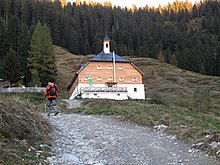Copper mining on the Kelchalpe
Traces of prehistoric copper mining on the Kelchalpe (Kelchalm in Aurach near Kitzbühel ) in Austria at the beginning of the Late Bronze Age were discovered by M. Much at the end of the 18th century. It contained stone implements ( anvils ), fragments of wooden vessels, ceramics, knocking stones, base plates and animal bones. His finds are now in the study collection.
Excavations in the 1930s to 1950s revealed copper ore processing in the form of cutting sites and hearths on the Kelchalpe. In Tyrol there were such places near Kitzbühel at Röhrerbühel and on Schattberg, on the Wildseeloder near Fieberbrunn as well as on the Kelchalpe and the Wildalpsee (at 2030 m altitude). The early copper mining, as can be seen from the finds, was carried out in so-called “underground” clusters. Tunnels were built in the mountain near the surface of the earth, which at Mitterberg near Bischofshofen reach a length of up to one and a half kilometers. Pinging reveals the mostly dilapidated tunnels by sinking in the soil above the tucked-in, which shows the subterranean course of the tunnels in their arrangement. Often there are pings next to each other in several rows. Occasionally, shafts from that time have also been discovered. Many traces of the Bronze Age have been erased by later mining. Due to the finds, however, the entire copper processing process during the Late Bronze Age could be traced. The procedure is clearest on the Mitterberg, less well on the Kelchalpe. Here the pings are irregularly distributed, lie in groups or are scattered. The tunnels collapsed in the slightly weathered clay slate and destroyed by water. According to the devices found, the relics found on the Kelchalpe belong to the same time as those on the Mitterberg and Reichenhall. The tools of the Kelchalpe are made of erratic granite . Their processing took place near the pinges. On the other hand, there are no traces of a smelting site to be seen here, probably because there was no water for the last separation and wood for the melting on the heights. The melting process therefore took place in deeper layers.
To feed the miners, alpine farming was carried out on site, traces of which were also found. The finds from excavations of the 20th century are exhibited in the Kitzbühel City Museum.
literature
- Michael Klaunzer: Studies on the Late Bronze Age mining on the Kelchalm and Bachalm District Kitzbühel, North Tyrol. Innsbruck 2008 (Innsbruck, University, diploma thesis, 2008).
- Ernst Preuschen, Richard Pittioni : Investigations in the Kelchalm mining area near Kitzbühel, Tyrol. 3. Report on the work 1946–1953 on the prehistory of copper mining in Tyrol (= Archaeologia Austriaca. H. 15, ISSN 0003-8008 = Archive for prehistoric and prehistoric mining research. Communication. No. 7). Deuticke, Vienna 1954, pp. 2-97.
Coordinates: 47 ° 23 ′ 17.1 ″ N , 12 ° 27 ′ 51.5 ″ E
